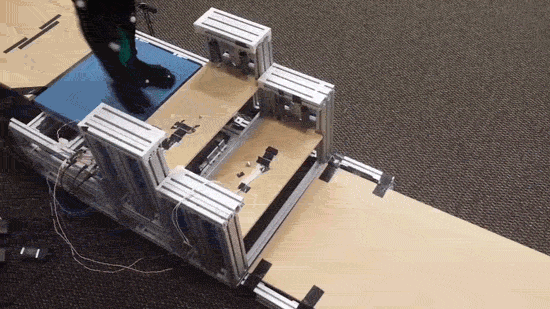Georgia Tech inventors have created assistive stairs that are an inexpensive, effective option for stair use by applying the principle of energy recycling. The objective with this technology was to design energy recycling assistive stairs (ERAS) that store energy during stair descent and return it to assist the user during stair ascent. Each ERAS is a single stair step designed to be placed on an existing step, with each module equipped with its own latch, sensor, and set of springs. When the tread is fully lowered, it contacts an electromagnetic latch at the bottom and pressure sensors detect foot placement during both ascent and descent. Energy stored in the springs are released back to the user as they ascend the steps. With stair descent being just as energy-demanding and challenging for older adults with a large risk for falls, ERAS’s are able to assist with the descent process as well. When the springs are removed or their motion is locked, ERAS modules do not recycle energy and are therefore equivalent to a normal set of stairs.
- ERAS are the only energy-recycling device tailored for assistance during stair movement.
- The modular design of ERAS allow for quick and easy installation (and removal, if necessary) on top of an existing staircase without expensive remodeling.
- The low-cost and low-power design allow ERAS to be more affordable and practical to people with limited financial resources.
- ERAS promotes the users to practice, retain or regain the ability to use normal stairs.
- ERAS are an effective alternative to the existing high-power and expensive options such as elevators, escalators or stair lifts.
- The modular ERAS can easily integrate onto existing stairs, making homes and communities more suited for aging-in-place.
- ERAS can assist with rehabilitation of people with reduced mobility for stair negotiation.
- Future designs could allow multiple users to consecutively ascend or descend.
Stair movement is a demanding task that limits the independence of individuals with mobility impairments such as muscle weakness, joint pain, or reduced sensorimotor control. Joint movements in the knee are over three times greater when using stairs compared to level walking, and stair use is ranked among the top five most difficult tasks for older adults. Current solutions providing assistance in stair negotiation are costly, energy-consuming, and do not help to retain the user's ability to use existing stairs. Independent elevators or stair-lifts are often impractical to install because they require substantial household remodeling. Perhaps more importantly, elevators or stair-lifts replace the use of stairs altogether, an issue as studies suggest the disuse of a specific motor function can further accelerate its loss. There is a need for a low energy option that utilizes current stairs and will prevent further motor decline.

The technology reduced the workload during an ascent by 17 percent overall and the work of the knee joint by 37 percent. Photo by Georgia Tech
